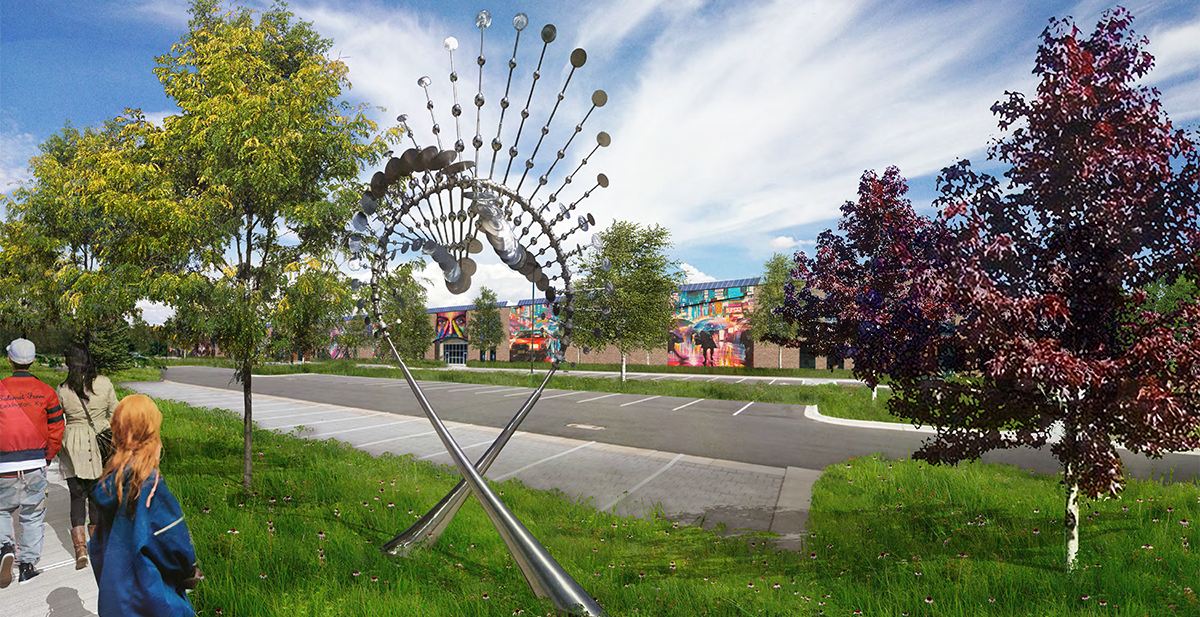The St. Paul Port Authority Sets Its Sights on Developing a Carbon-Free Community
The Port Authority’s Monte Hilleman speaks with ENTER about building advanced sustainability and living-wage jobs into the redevelopment of the former Hillcrest Golf Course
By Ann Mayhew | June 10, 2021
Hillcrest arts/employment district. Concept imagery: LHB.
FEATURE
Where some people see only a brownfield, others see an opportunity for an equitable, sustainable, and regenerative future.
The St. Paul Port Authority, an economic development agency focused on creating quality workforce opportunities, is waiting for the master plan for its next project—the redevelopment of what was formerly Hillcrest Golf Course—to be finalized by the City of St. Paul. The 112-acre property was purchased by the Port Authority in 2019.
Currently in the pre-certification process for LEED for Communities Platinum, the Hillcrest redevelopment is expected to feature 12 megawatts of rooftop solar, ultra-efficient buildings, and up to 20 acres of green space, all while adding 1,000 housing units and 1,000 living-wage jobs to St. Paul’s East Side.
“We’re trying to build a truly carbon-free community,” says Monte Hilleman, St. Paul Port Authority senior vice president of real estate development. “We’ve looked around the world and, while there a lot of plans and attempts and strategies, we haven’t been able to find one net-zero, carbon-free community for infrastructure, buildings, and transportation.
“LHB has been helping us create and plan energy-efficient and low-carbon solutions for over two decades, but this is a significantly bigger push,” Hilleman adds. “Their team has actually done the math to show us how we can do this—about how much it will cost and save the occupants.”
The Port Authority appears well prepared for the challenge. It recently completed 10 years of economic development at the Beacon Bluff Business Center, and it has extensive experience in tackling the grading, remediation, and infrastructure the contaminated Hillcrest land requires.
“We knew the site was contaminated; we didn’t know how much,” says Hilleman. “We knew there was no infrastructure, no planning. It was a huge land development opportunity in an era where we are struggling for industrially zoned land.”
“We’re not going to solve the racial wealth gap we see in our communities with the same kinds of conventional thinking and conventional real estate models that we’ve used for the last several decades. We have to reposition and retool the fundamental underpinnings of how we build these development projects.”
The Port Authority prioritizes equity from the outset of its development projects, beginning with the ability to zone land for light industrial uses. “Industrial land might not be the coolest thing,” says Hilleman, “but the economic vitality it brings to our city is amazing. If we can’t get the community and planners on board with providing enough industrial land to site jobs, we are literally starving the city for low-barrier-to-entry jobs that are desperately needed, primarily in BIPOC, low-income communities.”
The Port Authority’s development criteria require a 10-year workforce agreement, with one job per 1,000 square feet and living wages based on the Port Authority’s living-wage calculator, which is updated regularly. Density is also required, with a floor area ratio (the building floor space divided by the property’s land area) of 35 percent.
Other Port Authority workforce development tools include job training programs. Hilleman’s team is collaborating with the East Side Employment xChange, a group of service providers that is working to create a pipeline into businesses on the East Side. Hilleman sees opportunities at Hillcrest for training focused on solar energy.
The Port Authority’s approach to development is designed to help right environmental wrongs by cleaning up contaminated sites and rebuilding with an emphasis on job creation and high standards of sustainability that build wealth and equity in the local community. But optimizing planning for both climate action and equity is a complex endeavor.
LHB architect Becky Alexander, AIA, acknowledged the challenge in an A’20 MN conference panel on the Hillcrest redevelopment. “While some strategies, like access to transit and tool-sharing, can clearly support both carbon and equity goals, other carbon strategies have the potential to actually widen disparities, depending on the implementation mechanism,” Alexander explained. “For example, improving the energy efficiency of homes will reduce the energy burden of households—as long as it doesn’t price those households out of the market first.”
Hilleman agrees. “While we might be doing something right for sustainability, we could be saying ‘no’ to the types of buildings and land uses that could bring living-wage jobs with low barriers to entry,” he says. “We have to figure out [the right mix]. Maybe bike-ability and walkability, for example, are sacrificed in a segment of the site to allow for large-format land uses that are going to bring good jobs to the neighborhood.
Hilleman shared another example at the conference: “If we’re talking about not putting natural gas in this community, what does that mean for an entrepreneur who wants to open an ethnic, culturally significant restaurant and has spent their life, their career, learning to cook with natural gas tools?” Alexander recently proposed a potential solution: a retraining program and assistance to support people who need to buy and learn to use induction-cooking equipment.
“We’re not going to solve the racial wealth gap we see in our communities with the same kinds of conventional thinking and conventional real estate models that we’ve used for the last several decades,” Hilleman continues. “We have to reposition and retool the fundamental underpinnings of how we build these development projects to accomplish both equity and regenerative development.
“Why do we want to make sure we have a range of quality affordable housing? Quality open space and recreational amenities? Living-wage jobs with low barriers to entry? Because when we have those bases covered—when we feel safe from outside risks to our homes and our families—it allows us to feel joy. Our drive and purpose [at the Port Authority] is to build economically vibrant communities, and that should definitely include a healthy dose of joy.”




